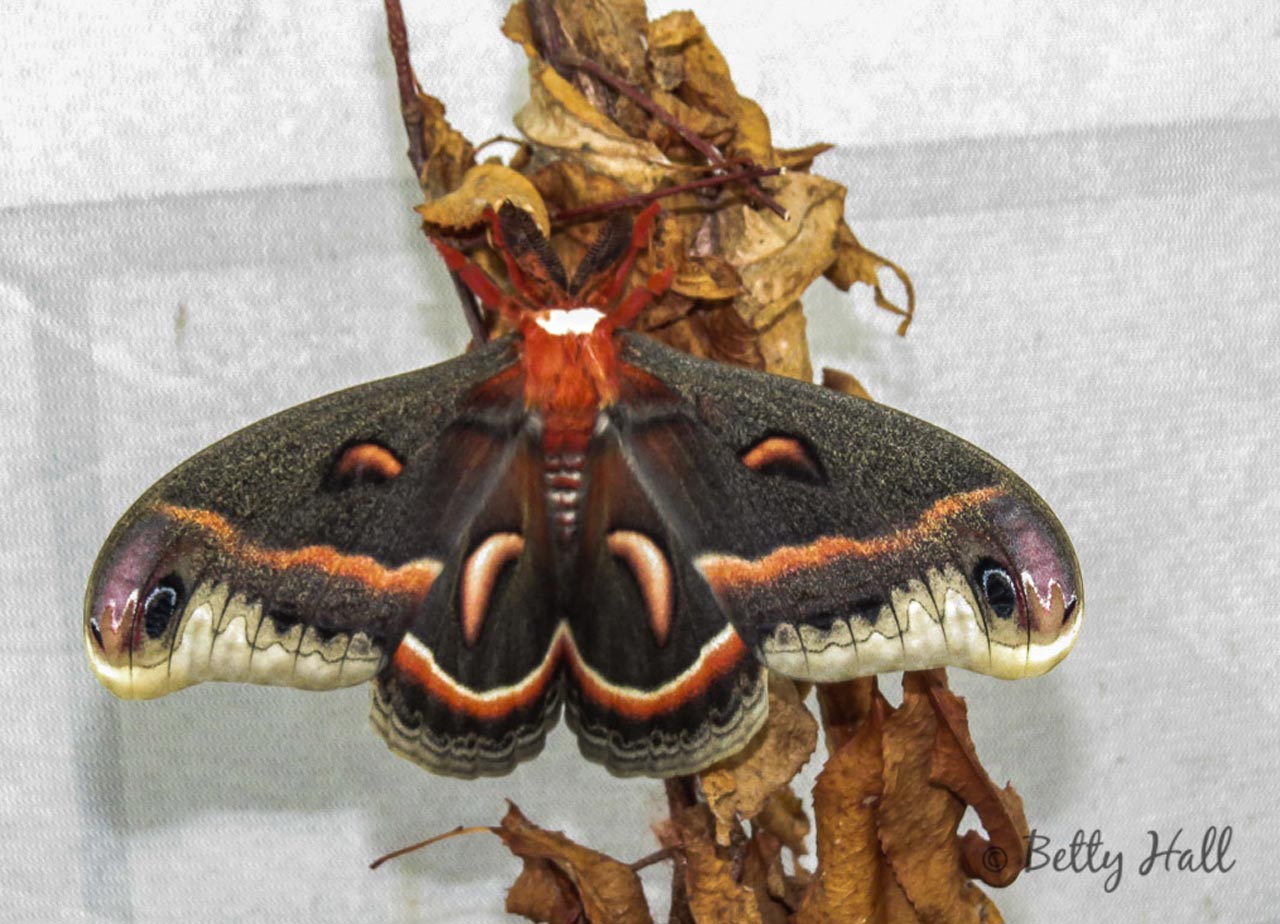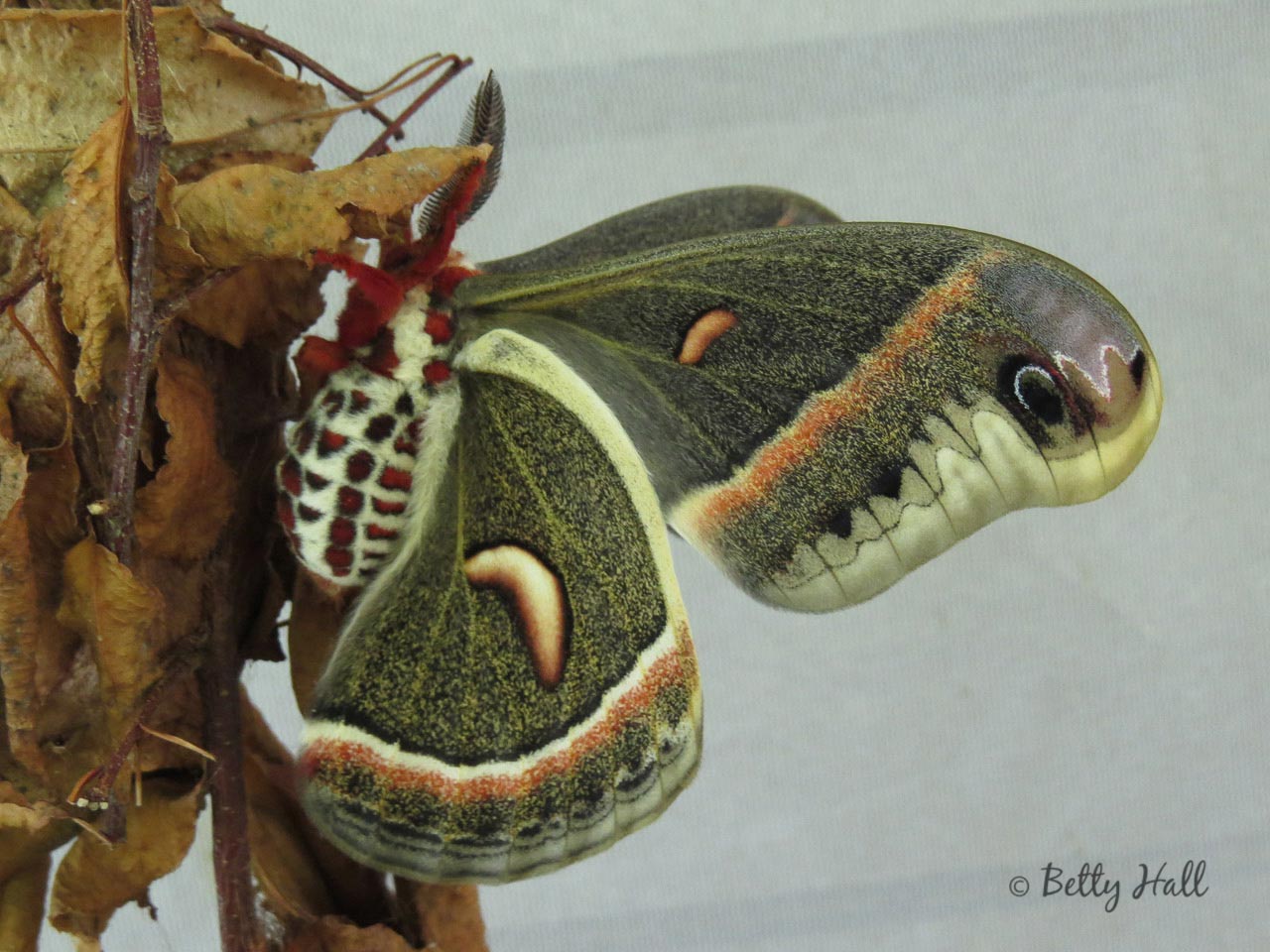Our Cecropia story began in 2012 when an injured moth laid eggs. Caterpillars from those eggs overwintered as cocoons, and emerged as moths last spring. One of those moths mated and laid eggs. The caterpillars grew and made cocoons that I left outside all winter. I was delighted to recently discover that this third generation moth had emerged.
The Cecropia (Hyalophora cecropia) is our largest North American moth. It amazes me that they have no mouth parts and do not eat during their short life of about two weeks. An earlier blog post includes more photos and a video of their life cycle.
I’m in awe of their colors and design. A view of the underside gives a better view of the feathery antenna and colorful abdomen. As the moth continued to pump fluid into its wings, the abdomen became considerably smaller.
Last summer I gave about 70 small cecropia caterpillars to folks who were interested in raising them. I’m hoping many of these people also get to see moths emerge and appreciate their beauty up close.




As you know, Betty, one of my beautiful moths emerged a week or so ago. Gorgeous creature! Raising the caterpillars was really something – so huge, and we could hear them eating. And eating. And eating! Thank you for this amazing experience.
Ann, glad you were willing to feed, and feed, and feed them! And delighted that you got to see the adult up close.
We released one of our moths on Derby Day. We released it and wished it well. there are wild cherry trees all around so it is in a good place. I gave one to a school in Irvine and still have one left. Thanks for sharing this special experience with us all.
Linda, thanks for letting me know. Yours emerged one day ahead of mine. Good to think of these creatures emerging in different areas.
I fretted and fretted all winter over my five cocoons.. First we housed them in the outhouse, then it seemed too cold for them and we moved them to an unheated room in the house. One emerged this morning, four more to go! Right now she is outside and I am anxiously watching her to protect her from bats or any other creature that might like to eat her! An incredible experience for me, and for the many children and adults who had the opportunity to watch the tiny caterpillars grow and make their cocoons in the Caterpillar Castle at Fantasy Forest. Thank you for sharing. And thanks to Amanda for rescuing the wounded mother.
Connie, I’m thinking these creatures of the wild who seem so fragile are evidently much tougher than we realize. Glad to know you, too, have enjoyed the experience from caterpillar to adult. I thank you for all you’ve done, and are doing to share such experiences with others via the Caterpillar Castle at Fantasy Forest.
What a beautiful moth, Betty, and well done for passing on caterpillars to other
interested folk. It’s wonderful to know how many caring people there are out there!
I would like to think that similar projects are happening all over the U.K. Looking forward to viewing more beautiful moths and butterflies.
Pauline, yes, it’s been quite satisfying to share various caterpillars and to see the interest of others – children and adults. A friend (95 years young) raised her first butterfly last summer and she’s enthusiastic about repeating the process. It’s a pleasure to be a part of such experiences.
Beautiful, Betty! We are still waiting for ours to emerge–hope they are OK!!!! Susan
Susan, I hope so, too. I know the uncertainty is challenging.
What a wonderful gift, Thanks
Betty,
What plants do the caterpillars favor? I am working on my gardens, incorporating KY natives and, if we buy the home we are renting, a large-scale transformation will take place.
Irene
Irene, glad to know you are thinking about natives and caterpillars. I will send you some information with ideas. Would also be glad for you to come see some of our backyard plants that provide caterpillar food.